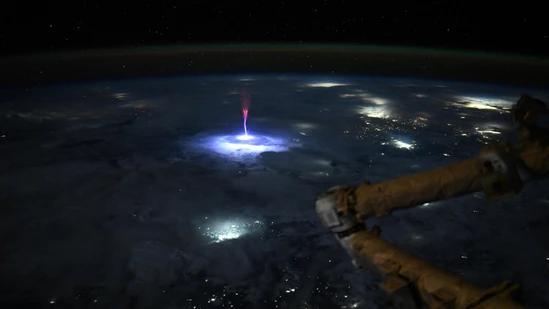
NASA Astronaut Captures Rare ‘Sprite’ Lightning Over US & Mexico
In a thrilling discovery, NASA astronaut Nichole Ayers has captured a rare and breathtaking image of a ‘sprite’ lightning phenomenon from the International Space Station while orbiting above the United States and Mexico. This extraordinary atmospheric phenomenon is a type of Transient Luminous Event (TLE), characterized by brief bursts of light that occur above thunderstorms.
The stunning photograph, shared by Ayers, showcases a vibrant display of ‘sprites’, which are elusive and relatively unknown atmospheric phenomena. These fleeting events are often difficult to capture, making Ayers’ image a significant achievement.
What are Sprites?
Sprites are a type of upper-atmospheric lightning that occurs at altitudes of around 50-100 km (30-62 miles) above the Earth’s surface. They are triggered by strong electrical discharges within thunderstorms, which create a channel of ionized air molecules, allowing the discharge to propagate upward.
During this process, the ionized air molecules emit light, resulting in the characteristic sprite displays. These events are extremely rare, as they require a specific combination of atmospheric conditions and thunderstorm activity.
Ayers’ Image: A Breakthrough in Understanding Sprites
Ayers’ photograph provides a unique opportunity for scientists to study sprites in greater detail. The image shows a vibrant, branching pattern of light, with multiple ‘springs’ of light radiating from a central point. This remarkable capture will allow researchers to better understand the relationship between sprites and thunderstorms.
According to Ayers, “Scientists can use these types of photos to better understand the dynamics of sprites and how they relate to thunderstorms. This will help us improve our understanding of the complex interactions between the atmosphere and the ionosphere.”
The Significance of Ayers’ Discovery
Ayers’ image is not only a striking visual representation of a rare atmospheric phenomenon but also a significant contribution to the scientific community. By capturing this image, Ayers has provided valuable data that will aid researchers in their quest to understand the intricacies of sprites and their connection to thunderstorms.
This breakthrough discovery has the potential to shed new light on the complex interactions between the atmosphere and the ionosphere, ultimately contributing to a deeper understanding of the Earth’s magnetic field and the impact of human activities on the environment.
Conclusion
NASA astronaut Nichole Ayers’ incredible capture of a ‘sprite’ lightning phenomenon is a testament to the importance of space-based research and the significance of capturing rare atmospheric events. As scientists continue to study Ayers’ image, we can expect new insights into the dynamics of sprites and their relationship to thunderstorms.
This remarkable discovery serves as a reminder of the awe-inspiring beauty and complexity of the Earth’s atmosphere, and the importance of continued exploration and research to better understand our planet.






